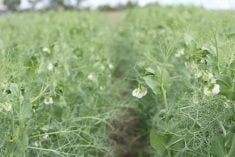Durum seeding intentions are heading in opposite directions in Canada and the United States.
The Canadian Wheat Board estimated in its latest Pool Return Outlook that Canadian growers will increase plantings by 23 percent and Agriculture Canada forecasts a 28 percent increase.
By contrast, U.S. farmers told the U.S. Department of Agriculture they planned to seed 2.37 million acres this spring, down eight percents from 2.57 million in 2010 and below trade expectations of 2.55 million.
Erica Olson, North Dakota Wheat Commission marketing specialist, said durum prices are good historically but well below spring wheat prices.
Read Also

Prairies have variable soil moisture conditions
The dry weather in the west was welcome for preserving grain quality and advancing harvest, but it has resulted in very dry soil moisture conditions.
Most farmers expect a premium to plant durum because it is a riskier crop to grow because of disease damage and the potential for harvest rain causing colour loss.
“The other thing is, even though prices have been good, producers have been hit with quality discounts at harvest time,” she said.
The USDA forecasts 1.28 million tonnes of U.S. ending stocks in 2010-11, up from the long-term average of 900,000 tonnes.
Ending stocks could be higher if annual exports don’t reach the USDA’s estimate of 1.09 million tonnes, which is increasingly likely.
That is partly because of poor sales to Algeria, which had bought 103,400 tonnes of U.S. durum as of March 31, down from 185,900 tonnes the same time last year.
In August, the Algerian grains agency imposed a tax on private durum imports to encourage millers to buy local supplies. The tax remains in place.
Canadian exports to Algeria are also down, but Olson believes Canada has a competitive advantage because U.S. sales are made through private importers who must pay the tariff, while Canadian business is done through government importers who do not have to pay it.
The 2011 durum crop is off to a good start in Europe, but it could still be a big importer because acreage is down and the euro has appreciated against the U.S. dollar. Crops in North Africa and the Middle East also had a good start, but it has turned dry in recent weeks in Algeria.
The real market mover will be Statistics Canada’s seeding intentions report, set for April 26.
Olson’s industry contacts expect a 30 to 40 percent increase in Canadian plantings, only partially making up for last year’s 2.5 million acre decline.
Anything less than that would support for prices, said Olson.
She said the expected 200,000 acre decline in durum acres in North Dakota could climb higher if wet conditions force changes in seeding plans. The same could be said for Canada.















